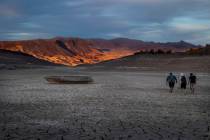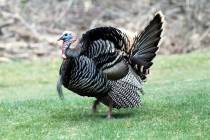Seeking out water, food sources can lead to successful dove hunt
I don't know what it is about dove season, but it always seems to attract at least one good thunderstorm to Southern Nevada. Those storms always seem to come just before opening day and make a challenging hunt even more so.
Storms like the one that rolled through the Las Vegas area earlier this week can push many of the doves that have migrated into the area farther south along their migration route. From here they fly into Arizona and California on their way to parts farther south, well out of range for most of us.
Just how many birds have opted to fly south this week remains to be seen. The good news is that because doves are a migratory bird, more should be on the way.
If the storm didn't push the birds farther south, that doesn't mean we're out of the woods. Natural water tanks, dry lake beds and depressions in the ground can hold rainwater for days or longer. That means doves have a wider variety of watering options than they did a few days ago. Increased watering options will spread the birds across the desert and make hunting tougher than it would have been before the storm.
If some of the birds have moved south, we can't do much about it. And with more water available in nearby areas, doves won't have to concentrate on specific water sources -- we can't do much about that either.
What we can do is adjust our hunting plans to the new situation in the field. Birds will be available to hunters willing to put in the time and the effort. Just remember that putting a few birds in your cooler will take more work than in normal years.
Like most of us, doves are creatures of habit. In the morning, they fly between water and feeding areas. They do the same in the late afternoon. Hunters can take advantage of that habit to bag a few birds. The key is finding water and food sources.
Sunflowers and other seed-bearing plants are a good place to start when looking for food. For water, I like to look near normally dry lake beds. A few places on those lake beds usually will hold rainwater for several days or longer.
Another place to find water and food sources are old stock tanks or old corrals. They are more common in the desert than some folks believe. Stock tanks can be made of steel or concrete, or they can be simple ponds created when someone pushed dirt into banks with heavy equipment. Either way, doves will use these tanks when they have water in them. And don't forget natural springs.
Southern Nevada once was home to a variety of agricultural areas, a veritable smorgasbord for doves and other upland game birds, but those days are just about over. (If the fields aren't covered with water-friendly golf course communities complete with streams and waterfalls, they soon will be.) Hunters willing to drive might find opportunities in the agricultural communities north of Las Vegas, in northern Arizona or even in California.
Though I never have experienced it, many hunters have told me the dove hunting in Blythe, Calif., can be worth the travel time.
If you like a more formal setting, you might consider one of Nevada's wildlife management areas. The Nevada Department of Wildlife temporarily has closed the Overton WMA while the agency deals with a herd of cantankerous range cattle that have shown a dislike for humans. Good shooting can be expected at the Key-Pittman and Kirch Wildlife Management areas to the north on Highway 318. Both held doves when I passed through that country last week, but you can expect company.
• SIGHT IN RIFLES -- If you are looking for a place to sight in your hunting rifles, you might want to take advantage of the free range day offered by the Desert Sportsman's Rifle and Pistol Club and NDOW. You can do so at the club's shooting range on Sept. 8. The club has set aside its 300-yard range for use by the public. Free targets will be provided.
The club is located at 12201 W. Charleston Blvd. Shooting hours are 8 a.m. to 5 p.m.
Contact Martin Olson at 702-486-5127 for reservations.
Doug Nielsen is an award-winning freelance writer and a conservation educator for the Nevada Department of Wildlife. He can be reached at doug@takinitoutside.com.
C. DOUGLAS NIELSENMORE
COLUMNS

















